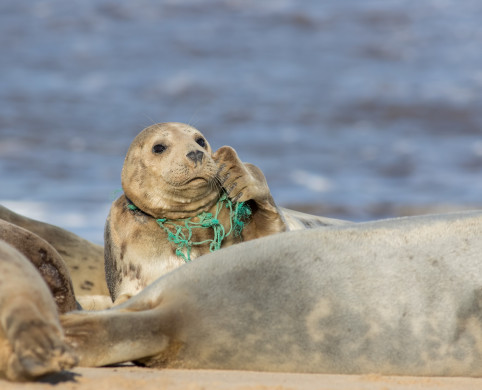Global Environment

21st Century environmental challenges require international action and cooperation.
Advocates working on global environmental issues develop and implement legal agreements and treaties among countries to protect and manage shared resources or to address global issues such as climate change, biodiversity loss, ocean resources, and ozone depletion. Advocates also develop and support the domestic environmental laws of various countries.
Coursework
This class takes an in-depth look at our greatest global environmental challenge, climate change, through a discussion of the international treaty regime.
It will begin with an overview of climate science and a discussion of the existing and expected impacts of climate change. Next, the course will discuss the United Nations Framework Convention on Climate Change (UNFCCC), the Kyoto Protocol, the Paris Agreement, and the associated Katowice rulebook. Time permitting, the course will discuss related hot topics such as climate and pipeline litigation and the role of non-state actors.
This class will discuss U.S. law and policy. It will begin with an overview of climate science and a discussion of the existing and expected impacts of climate change. Next, the course will discuss federal laws, regulations, and policies that regulate greenhouse gases and otherwise address climate change impacts. The course will then discuss state and local approaches to address climate change.
The class will also discuss climate change litigation in federal and state courts. Time permitting, the course will compare U.S. approaches to climate change law and policy in other countries.
This course examines the principal laws and institutions in the field of international environmental law. The course begins with a review of the fundamental underpinnings of environmental and international law, including the precautionary principle, polluter pays principle, state responsibility for environmental harm, and permanent sovereignty over natural resources.
The course next examines issues of the global commons, such as ozone depletion, climate change, and depletion of ocean resources. It explores international treaties to protect biological diversity, including the Convention on International Trade in Endangered Species, the Convention on Biological Diversity, and the International Convention for the Regulation of Whaling.
It also examines major pollution issues, such as hazardous waste trade. Throughout these discussions, we examine development issues, the polarization of issues as developed and developing country issues, and the role of nongovernmental organizations (NGOs) in the development and enforcement of international environmental law.
This course provides an in-depth treatment of international trade law by examining its frequent clash with environmental goals and law.
International trade law, as embodied in the World Trade Organization, GATT, and the US-Mexico-Canada Free Trade Agreement, establishes rules to reduce barriers to trade in goods, services, and investments. It does so by prohibiting countries from discriminating against foreign products based on the way they are produced (e.g., unsustainable fishing practices or without pollution control technology), limiting the use of quotas and subsidies to meet national goals, requiring substantial scientific evidence to justify restrictions on pesticide levels on food to protect human health, and restricting the authority of national and sub-national governments to favor local investors over foreign investors.
Despite these rules, countries often use trade measures to restrict imports of environmentally harmful products or products produced in unsustainable ways. They also subsidize environmentally preferable products. such as solar panels.
By examining trade law and its trade liberalizing rules in light of environmental protection, students will explore areas of convergence and conflict between two legal regimes intended to promote human welfare and sustainable development. The course analyzes all the major trade-environment disputes, including Shrimp/Turtle, Tuna/Dolphin, the European ban on meat products containing growth hormones, disputes over genetically modified foods, solar panels, and carbon taxes.
This class takes an in-depth, real-life look at the complex of multilateral treaties that concerns international wildlife management, including the Convention on International Trade in Endangered Species of Wild Flora and Fauna, the Convention on Migratory Species, the United Nations Law of the Sea Convention, regional fisheries management agreements, and the International Convention on the Regulation of Whaling.
In addition to achieving competence in the various treaty mechanisms, students will have the opportunity to explore contemporary wildlife issues that currently make these treaties dynamic, “living” documents. These issues include, inter alia, Japanese whaling and the legitimacy of the International Whaling Commission; the African elephant ivory trade and the tension between conservation and sustainable use to support livelihoods; the management of commercially exploited species, especially tuna species; enforcement, consumer demand, and rhino horn trade; and the polar bears future in light of climate change impacts.
International law is a vast field permeating many other fields of law in an increasing interconnected world. This course introduces students to the basic tenets of public international law, including its nature and sources, its application in international and national settings, and its role in settling disputes.
Subject matter areas covered will include, among others, the interaction between international and municipal law, the recognition and responsibility of States, self-determination, limits on the use of force, international courts and organizations, and the law of the sea and other common spaces. Students will develop the ability to analyze contemporary world events and how international law might apply to these situations, ranging from global environmental problems and human rights abuses to armed conflict and international crimes.
This course will provide a solid foundation for those wishing to study international law in greater depth and pursue courses and careers in related fields.
Many experts believe that the world now faces the sixth episode of mass extinction for life on planet Earth – this one caused by humans. This course focuses on how law in the United States tries to avoid such an outcome.
The class examines legal mandates for protection and management of biological diversity. Beginning with a brief overview of the scientific aspects of species, ecosystems, and genetic resources, the course includes consideration of interplay between science and law throughout its survey of laws related to wildlife. Substantively, the class analyzes the property and constitutional underpinnings of state and federal wildlife laws, looks at examples and structures of state regulation of wildlife, and examines the special case of American Indians’ rights to, and control over, wildlife resources.
The course also focuses on several federal statutory schemes, including the Lacey Act, Marine Mammal Protection Act, Migratory Bird Treaty Act, and laws and policies aimed at controlling invasive species. The course considers federal management of wildlife habitat under statutes such as the National Forest Management Act and National Wildlife Refuge System Improvement Act, and briefly covers international efforts to protect biodiversity. Due to the statute’s broad influence on the field, the class devotes particular attention to the federal Endangered Species Act.
We also offer courses useful to students in any type of environmental practice such as Environmental Litigation, Environmental Mediation and Negotiation, Environmental Law Moot Court, Energy Law Moot Court, and the Supreme Court and the Environment. Students may also opt to do an individual research project (paper) on a topic of interest in this area.
Alumni on the Front Lines
 International Legal Director, Senior Attorney Center for Biological Diversity
International Legal Director, Senior Attorney Center for Biological DiversityFighting the extinction crisis internationally, I focus on the exploitation driver of extinctions especially given the significance of the U.S. market. My Lewis and Clark education set me up well to advocate for foreign species using both domestic and international legal tools.
 Director of International Programs at the Environmental Law Institute (ELI)Founding President of the Environmental Peacebuilding Association (EnPAx)
Director of International Programs at the Environmental Law Institute (ELI)Founding President of the Environmental Peacebuilding Association (EnPAx)I work at the intersection of environment, conflict, and peace. I love helping countries such as Liberia and Colombia to rebuild their economies, livelihoods, and the social fabric after conflict. It is challenging to find solutions that are both environmentally sustainable and socially equitable. The work is always interesting, sometimes frustrating, and when we do a good job incredibly impactful and fulfilling.
 Western and Central Pacific Tuna Programme Manager, World Wide Fund for Nature, New Zealand
Western and Central Pacific Tuna Programme Manager, World Wide Fund for Nature, New ZealandI feel a responsibility to advocate across various international forums on behalf of our ocean and its inhabitants to ensure a sustainable future for humanity.
Doing the Work
Gain practical experience in global environmental issues through our on-campus clinics and institutes:
Earthrise Law Center Global Law Alliance Green Energy Institute
Featured News
Why Wild Animals Need a Global Plastics Treaty
This Earth Day, Clinical Professor Erica Lyman explains why it will take global action to protect wild animals from the harmful effects of plastics.
Environmental, Natural Resources, and Energy Law is located in Wood Hall on the Law Campus.
MSC: 51
email elaw@lclark.edu
voice 503-768-6649
Environmental, Natural Resources, and Energy Law
Lewis & Clark Law School
10101 S. Terwilliger Boulevard MSC 51
Portland OR 97219
